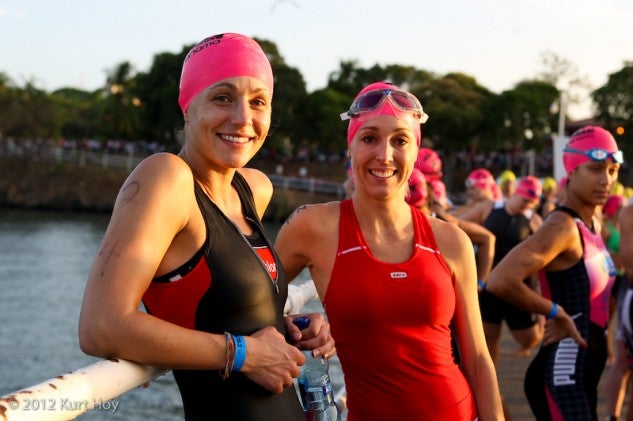How To Approach Your Early-Season Half Ironman

Two athletes prepare to race at Ironman 70.3 Panama. Photo: Kurt Hoy
Assuming most triathletes have a long season ahead—with an A race in a few months—strategizing for an early-season “dust off the cobwebs” 70.3 can be tricky. You don’t want to be in your most peak shape, yet you want to make a proud showing come race day. For those competing in upcoming March or April races, here’s some advice for how to handle your taper and race strategy.
Your Taper Plan
“Your early season race doesn’t need a 10- or 14-day taper as you simply haven’t built up that much by this point in your season,” says coach Patrick McCrann of Endurance Nation. McCrann’s athletes take the winter training approach of “fast before far”—building speed in the off-season with minimal distance work—before six to eight weeks of concentrated half-Ironman training. If you’ve been following a more traditional plan (building long, slower base miles first before moving on to speed), he suggests one final long ride and run on the Saturday before race weekend.
You can probably get away with a one-week taper so you’re sharp but not too sharp at the starting line. Endurance Corner coach Gordo Byrn keeps his athletes’ tapers short for March and April events. “I don’t want to shed too much training load for the early season races so I have the athlete rest more after the event, rather than before,” Byrn says.
These tapering tips can help you remember specifics for the week of the race.
Your Race Strategy
The good news is that if this isn’t your A race, there’s less pressure for a PR, which allows you to set more specific goals outside of a finishing time. “You might consider pushing one element of the race simply to test your ability to handle the effort; after all there’s no place like race day to see what you are capable of!” McCrann says. Try one of these approaches:
• Focus on your weakest sport. “I like to work on the #1 race limiter that the athlete needs to address for his A race later in the year,” Byrn says.” If you’ve struggled to be aggressive on the swim, test out your hard-earned winter pool fitness and go out hard. For the athlete who has never run to his potential, Byrn hinges the entire race on running a fast final 10K. “I remove pace/power pressure from the swim and bike so that the athlete learns what a fast run feels like. Most people never give themselves a chance to learn this lesson and it’s a lot of fun to be strong at the end.” For those with proven running prowess, Byrn will take a chance with bike pacing, having athletes base their bike strategy on riding key segments at close to functional threshold power.
• Play with pacing. Challenge yourself to negative split the bike or run (do the second half faster than the first). Or ride steadily and start the first three miles of the run 15- to 20-seconds slower than your goal race. “Once you are comfortable you can pick up the pace for the next seven miles and then, if you have anything left, really open it up over the last 5K. You’ll be amazed how many people you’ll pass en route to the finish line,” McCrann says. If you just started training with a power meter this year, now’s the time to test how well you can execute a pacing plan.
• Concentrate on skills. In the water, perfect your bilateral breathing, practice your drafting or sight with consistent form. Once you’re on the bike, strive for your optimal cadence and ensure you’re pedaling in nice, even circles. During the run, take short, quick strides uphill and avoid overstriding going downhill. Do a form check every mile: Are your feet landing directly under your hips? Are your shoulders scrunched up to your ears? Are you doing the Old Man Shuffle?
RELATED: Simple Half-Ironman Nutrition Advice
Bonus!
Your early-season race provides an opportunity to refresh your memory on what gear to pack, how to transition smoothly and how to nail your nutrition plan—all while allowing you to make a few mistakes. It also gives you the chance to make sure your gear is still in working order, considering you haven’t used some of it in the last few months. Be sure you inspect your wetsuit, find your aero helmet, stock up on tubes, etc. before the night of the race!
Patrick McCrann offers a detailed half Ironman seminar at Endurance Nation.
You can find helpful articles and training insight from Gordo Byrn at Endurance Corner.